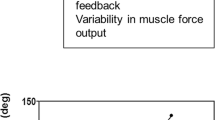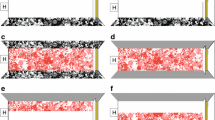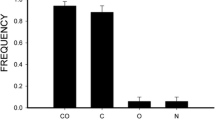Abstract
This review article is devoted to results on distance measurement in locusts (e.g., Wallace, 1959; Collett, 1978; Sobel, 1990) and mantids. Before locusts or mantids jump toward a stationary object, they perform characteristic pendulum movements with the head or body, called peering movements, in the direction of the object. The fact that the animals over- or underestimate the distance to the object when the object is moved with or against the peering movement, and so perform jumps that are too long or short, would seem to indicate that motion parallax is used in this distance measurement. The behavior of the peering parameters with different object distances also indicates that not only retinal image motion but also the animal’s own movement is used in calculating the distance.
Similar content being viewed by others
References
Autrum, H., and Wiedemann, I. (1962). Versuche über den Strahlengang im Insektenauge.Z. Naturforsch. 17b: 480–482.
Barros-Pita, J. C., and Maldonado, H. (1970). A fovea in the praying mantis eye. II. Some morphological characteristics.Z. Vergl. Physiol. 67: 79–92.
Chapman, R. F. (1955). A laboratory study of roosting behaviour in hoppers of the African migratory locust,Locusta migratoria migratorioides.Anti-Locust Bull. 19: 1–40.
Cloarec, A. (1986). Distance and size discrimination in a water stick insect,Ranatra linearis (Heteroptera).J. Exp. Biol. 120: 59–77.
Collett, T. S. (1978). Peering—a locust behavior pattern for obtaining motion parallax information.J. Exp. Biol. 76: 237–241.
Collett, T. S. (1987). Binocular depth vision in arthropods.TINS 10: 1–2.
Collett, T. S., and Paterson, C. J. (1991). Relative motion parallax and target localisation in the locust,Schistocerca gregaria.J. Comp. Physiol. A 169: 616–621.
Demoll, R. (1909). Über die Beziehungen zwischen der Ausdehnung des binokularen Sehraumes und dem Nahrungserwerb bei einigen Insekten.Zool. Jb. Syst. 28: 523–530.
Ellis, P. E. (1953). Social aggregation and gregarious behaviour in hoppers ofLocusta migratoria migratorioides.Behaviour 5: 225–260.
Eriksson, E. S. (1980). Movement parallax and distance perception in the grasshopperPhaulacridium vittatum (Sjöstedt).J. Exp. Biol. 86: 337–341.
Eriksson, E. S. (1985). Attack behaviour and distance perception in the australian bulldog antMyrmecia nigriceps.J. Exp. Biol. 119: 115–131.
Goulet, M., Chapman, R., and Lambin, M. (1991). The visual perception of relative distances in the wood-cricket,Nemobius silvestris.Physiol. Entomol. 6: 357–367.
Helmholtz, H. v. (1966).Handbuch der Physiologischen Optik, Voss, Hamburg.
Horridge, G. A. (1977). Insects which turn and look.Endeavour 1: 7–17.
Horridge, G. A. (1986). A theory of insect vision: velocity parallax.Proc. R. Soc. Lond. B. 229: 13–27.
Horridge, G. A. (1987). The evolution of visual processing and the construction of seeing systems.Proc. R. Soc. Lond. B 230: 279–292.
Horridge, G. A., and Duelli, P. (1979). Anatomy of the regional differences in the eye of the mantisCiulfina.J. Exp. Biol. 80: 165–190.
Huber, A. (1961). Zur Biologie vonMellinus arvensis.Zool. Jb. Syst. 89: 43–118.
Jeanrot, N., Campan, R., and Lambin, M. (1981). Functional exploration of the visual field of the wood-cricket,Nemobius sylvestris.Physiol. Entomol. 6: 27–34.
Kennedy, J. S. (1945). Observations on the mass migration of desert locust hoppers.Trans. R. Entomol. Soc. Lond. 95: 247–262.
Köck, A., Jakobs, A.-K., and Kral, K. (1993). Visual prey discrimination in monocular and binocular praying mantisTenodera sinensis during postembryonic development.J. Insect Physiol. 39: 485–491.
Lambin, M. (1984). Description des mouvements “oculaires” de la tete pendant la fixation visuelle chez un insecte.Biol. Behav. 9: 307–319.
Land, M. F. (1981). Optics and vision in invertebrates. In Autrum, H.,et al. (eds.),Handbook of Sensory Physiology, VII/6B, Springer-Verlag, Berlin, Heidelberg, New York, pp. 471–592.
Leitinger, G. (1994).Frühe postembryonale Entwicklung des Komplexauges und der Lamina gangionaris der Gottesanbeterin nach Photodegeneration der akuten Zone mit Sulforhodamin, Master thesis, University Graz, Graz.
Leitinger, G., Pabst, M.-A., and Kral, K. (1994). Foveale Applikation von Sulforhodamin hat strukturelle Auswirkungen auf die postembryonale Entwicklung des Komplexauges der Gottesanbeterin.Verh. Deut. Zool. Ges. 87: 252.
Liske, E., and Mohren, W. (1984). Saccadic head movements of the praying mantis, with particular reference to visual and proprioreceptive information.Physiol. Entomol. 9: 29–38.
Maldonado, H., and Barros-Pita, J. C. (1970). A fovea in the praying mantis eye. I. Estimation of the catching distance.Z. Vergl. Physiol. 67: 58–78.
Mittelstaedt, H. (1957). Prey capture in mantids. In Scheer, B. T.,et al. (eds.),Recent Advances in Invertebrate Physiology, University of Oregon Publication, pp. 51–71.
Pfaff, M., and Varjú, D. (1991). Mechanisms of visual distance perception in the hawk mothMacroglossum stellatarum.Zool. Jb. Physiol. 95: 315–321.
Poteser, M. (1995).Die Rolle der Eigenbewegung der Gottesanbeterin Polyspilota sp.bei der Entfernungsmessung zu stationären Objekten im Verlauf der postembryonalen Entwicklung, Master thesis, University Graz, Graz.
Poteser, M., and Kral, K. (1995). Visual distance discrimination between stationary targets in praying mantis: An index of the use of motion parallaxJ. Exp. Biol. 198: 2127–2137.
Rossel, S. (1979). Regional differences in photoreceptor performance in the eye of the praying mantis.J. Comp. Physiol. 131: 95–112.
Rossel, S. (1983a). Binocular stereopsis in an insect.Nature 302: 821–822.
Rossel, S. (1983b). Binocular vision in the praying mantis.Experientia 39: 640.
Rossel, S. (1986). Binocular spatial localization in the praying mantis.J. Exp. Biol. 120: 265–281.
Sobel, E. C. (1990a). The locust’s use of motion parallax to measure distance.J. Comp. Physiol. 167: 579–588.
Sobel, E. C. (1990b). Depth perception by motion parallax and paradoxical parallax in locust.Naturwissenschaften 77: 241–243.
Srinivasan, M. V., Lehrer, M., Kirchner, W., and Zhang, S. W. (1991). Range perception through apparent image speed in freely-flying honeybees.Visual Neurosci. 6: 519–535.
von Holst, E. (1969).Zur Verhaltensphysiologie bei Tieren und Menschen, R. Piper & Co. Verlag, München.
Walcher, F., and Kral, K. (1994). Visual deprivation and distance estimation in the praying mantis larvae.Physiol. Entomol. 19: 230–240.
Wallace, G. K. (1958). Some experiments on form perception in the nymphs of the desert locustSchistocerca gregaria Forskål.J. Exp. Biol. 35: 765–775.
Wallace, G. K. (1959). Visual scanning in the desert locustSchistocerca gregaria Forskål.J. Exp. Biol. 36: 512–525.
Weismann, R. (1937). Die Orientierung der Kirschfliege (Rhagoletis cerasi) bei der Eiablage.Landw. Jb. Schweiz 51: 1080–1109.
Zänkert, A. (1939). Vergleichend-morphologische und physiologisch-funktionelle Untersuchungen an Augen beutefangender Insekten.Sitzg. Ges. Naturforsch. Freunde Berlin 1–3: 82–169.
Author information
Authors and Affiliations
Rights and permissions
About this article
Cite this article
Kral, K., Poteser, M. Motion parallax as a source of distance information in locusts and mantids. J Insect Behav 10, 145–163 (1997). https://doi.org/10.1007/BF02765480
Revised:
Issue Date:
DOI: https://doi.org/10.1007/BF02765480




